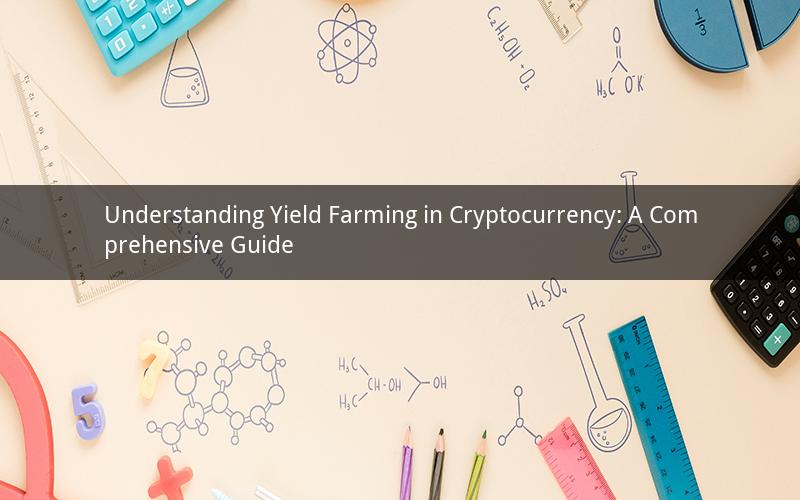
Yield farming, also known as liquidity mining, has become a popular concept in the cryptocurrency world. It allows users to earn returns on their cryptocurrency investments by lending or providing liquidity to decentralized finance (DeFi) platforms. This article aims to provide a comprehensive guide to yield farming, covering its definition, benefits, risks, and the key aspects to consider before participating.
1. Definition of Yield Farming
Yield farming refers to the process of earning interest or rewards by providing liquidity to a DeFi platform. Users deposit their cryptocurrency into a liquidity pool, which is a collection of tokens locked in a smart contract. In return, they receive a share of the platform's fees or rewards generated from trading activities on the platform.
2. Benefits of Yield Farming
a. High Returns: Yield farming can offer significantly higher returns compared to traditional interest rates on savings accounts. This is because DeFi platforms often incentivize users to provide liquidity by offering attractive rewards.
b. Diversification: By participating in yield farming, users can diversify their cryptocurrency portfolio and gain exposure to various DeFi projects.
c. Passive Income: Yield farming allows users to earn returns on their investments without actively engaging in trading or managing their portfolio.
3. Risks of Yield Farming
a. Smart Contract Vulnerabilities: Since yield farming involves interacting with smart contracts, users are exposed to potential vulnerabilities, such as bugs or malicious actors attempting to exploit the system.
b. Market Volatility: Cryptocurrency prices can be highly volatile, and yield farming can amplify the impact of price fluctuations on investment returns.
c. Platform Risk: Yield farming relies on the stability and reliability of DeFi platforms. If a platform fails or faces regulatory challenges, users may lose their investments.
4. Key Aspects to Consider Before Yield Farming
a. Research: Conduct thorough research on the DeFi platform and the specific tokens involved in the liquidity pool. Understand the project's goals, team, and track record.
b. Risks Assessment: Evaluate the risks associated with the platform and the tokens. Consider your risk tolerance and investment goals before participating.
c. Liquidity Pools: Choose liquidity pools with high trading volumes and strong community support. This reduces the risk of impermanent loss and ensures a stable reward distribution.
d. Token Selection: Select tokens with strong fundamentals and a solid market position. Avoid investing in tokens with high market risk or speculative potential.
e. Security Measures: Implement security measures, such as using hardware wallets or secure exchanges, to protect your investments from potential threats.
5. Common Questions About Yield Farming
a. What is impermanent loss, and how does it affect yield farming?
Impermanent loss refers to the potential loss in value of a cryptocurrency token when it is removed from a liquidity pool. It occurs due to price differences between the token's price in the pool and its price on the open market. Higher impermanent loss can be associated with tokens experiencing significant price volatility.
b. Can yield farming be considered a long-term investment strategy?
Yield farming is generally considered a short-term investment strategy due to the high risks involved. It is not advisable to rely solely on yield farming for long-term wealth accumulation, as the volatile nature of cryptocurrencies can lead to significant losses.
c. How can I calculate the potential returns from yield farming?
The potential returns from yield farming can be calculated by multiplying the amount of cryptocurrency deposited in the liquidity pool by the estimated annual percentage yield (APY). However, it is important to note that actual returns may vary due to factors such as market volatility and platform performance.
d. Are there any legal implications of yield farming?
The legal implications of yield farming vary depending on the jurisdiction. It is crucial to research the regulations in your country or region to ensure compliance with local laws and regulations.
e. How can I stay informed about the latest developments in yield farming?
Staying informed about yield farming involves following reputable news sources, joining DeFi communities, and actively participating in discussions. Additionally, keeping an eye on blockchain analytics platforms can provide valuable insights into market trends and potential risks.
In conclusion, yield farming in cryptocurrency offers the potential for high returns but comes with significant risks. By understanding the concept, conducting thorough research, and considering the key aspects, users can make informed decisions and maximize their chances of success in yield farming. However, it is essential to approach yield farming with caution and prioritize risk management to protect your investments.